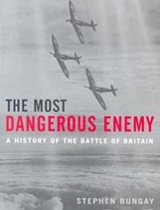The Most Dangerous Enemy – Book Review
 The Most Dangerous Enemy: An Illustrated History of the Battle of Britain. By Stephen Bungay. Zenith Press, 2010. 210 pages, hardcover. $40.00.
The Most Dangerous Enemy: An Illustrated History of the Battle of Britain. By Stephen Bungay. Zenith Press, 2010. 210 pages, hardcover. $40.00.
For most British, the Battle of Britain holds a place of reverence similar to the esteem that many Americans have for defining moments of American history, such as the American War for Independence or the Alamo. Even before the fight ended, the story of a few brave RAF pilots holding off the might of the entire Luftwaffe became part of the collective British identity and earned mythical legend status. As Winston Churchill eloquently opined during the height of the battle, “Never in the field of human conflict has so much been owed by so many to so few.”
Bungay’s work captures the real story and the real people, separating fact from myth.
I learned first-hand the high regard the British hold for the Battle of Britain when I visited the United Kingdom as part of the International Air Cadet Exchange in the late 1980s as a Civil Air Patrol cadet. It seemed nearly every historic site we visited emphasized its role in the battle. This ranged from the obvious locations, such as 11 Group operations bunker at RAF Uxbridge (with every detail at the height of the battle meticulously re-created, from the raid markers on the map board to the time on the wall clock) to the London Fire Brigade Museum, which highlighted its role in dealing with the aftermath of the German air raids. At that time in the 1980s, even operation RAF bases remained poised for action, with sandbagged fighting positions outside nearly every building. When I remarked about this to our RAF escort officer, his reply was a succinct, “We’ve been bombed; you haven’t.”
{default}In his book, The Most Dangerous Enemy, author Stephen Bungay takes a fresh look at the Battle of Britain. In his introduction, he recounts growing up immersed in the mythology of the battle, his parents having lived through many of the raids during the war. His first contact with the history of the battle came through a wartime Air Ministry pamphlet found in his father’s bookcase, which perpetuated the legend of lone RAF Spitfire pilots fighting off swarms of Luftwaffe bombers and prevailing against unimaginable odds. Bungay recounts how this myth began to die in the 1980s and 1990s as “debunkers” sought to tear down the myths. However, Bungay notes, in their zeal to dismiss, the debunkers missed the real story—the British won the Battle of Britain. Bungay’s work captures the real story and the real people, separating fact from myth and presenting us a fuller picture of the battle.
The people are the real factor that determined the outcome of the Battle of Britain. As Bungay puts it, “The Battle of Britain was not a near-run thing. The Luftwaffe never came close to achieving any of its confused objectives. The German pilots did as well as anyone might reasonably have expected. The difference that made the difference was the leadership.” Bungay does an excellent job capturing the story of the people and putting it into larger perspective of tactics, strategy, technology and relevance.
This version of The Most Dangerous Enemy is an update of the first edition published in 2000. The new version is profusely illustrated with over 150 photographs, full-color maps and diagrams, and numerous sidebar features. This is an outstanding book and likely to become the definitive account of the Battle of Britain.
Steve Schultz is a former active duty US Air Force officer and pilot. He holds a master’s degree in military history and writes from central Florida.


0 Comments
Trackbacks/Pingbacks